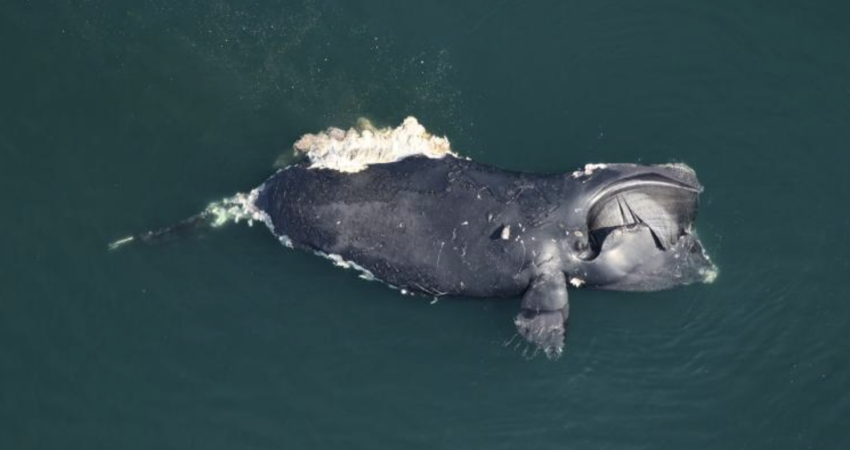The endangered North Atlantic right whale population took another hit with the discovery on March 30 of a dead breeding female whale off Virginia, an apparent victim of a ship strike just weeks after being seen off Georgia with a newborn calf, according to the National Oceanic and Atmospheric Administration.
The whale, known to researchers as #1950, was one of fewer than 70 breeding adult females in a population now estimated at only around 360 animals.
According to NOAA, the calf was not seen near the carcass, which was spotted by contractors doing Mid-Atlantic whale surveys for the Navy. The whale was found 50 miles offshore east of Back Bay National Wildlife Refuge in Va.
“NOAA Fisheries and our partners have towed the whale to shore for a necropsy,” the agency said. “The whale carcass was scavenged by sharks; wind, weather, and distance from shore presented additional logistical challenges for the tow.”
In an online update on April 4, the agency said the necropy suggested a ship strike was to blame.
"On April 2, experts conducted a necropsy on North Atlantic right whale #1950. Preliminary findings included catastrophic injuries: a dislocation of the whale’s spine and fractures to all vertebrae in the lower back, consistent with blunt force trauma from a vessel strike."
Ship strikes and entanglement in fishing gear are leading causes of human-caused deaths among the right whale population, according to NOAA and whale researchers. Environmental advocates pressed their case for NOAA to extend its 10-knot speed limits to smaller vessels when right whales are present.
“It’s déjà vu all over again — yet another mother-calf pair has been killed by a vessel strike,” asserted Jane Davenport, senior attorney at Defenders of Wildlife. “We cannot save this species if we keep killing off reproductive females. If the Biden administration doesn’t immediately finalize the expanded vessel speed rule, it will be directly responsible for driving the right whale to the brink of extinction.”
Under a rule dating from 2008, NOAA can direct vessels over 65 feet in length to maintain a 10-knot limit when the agency declares a management area active for protecting whales. Analyses of vessel tracking data by environmental groups and NOAA’s own audits have shown the rule is frequently broken, and the agency’ Office of Law Enforcement has stepped up speed enforcement using radar and Automatic Identification System (AIS) data.
However, environmental and wildlife groups point to cases where smaller vessels were implicated in whale strikes. NOAA’s proposal to apply the rule to boats between 35 and 65 feet has faced fierce opposition from charter fishing boat and coastal passenger vessel operators, recreational boat manufacturers, and their allies in Congress.
Meanwhile, another group of critics is focused on offshore wind energy development, contending that East Coast projects pose a dire threat to right whales. Elizabeth Quattrocki Knight, president and co-founder of the Rhode Island-based group Green Oceans, noted that the latest whale was found east of waters planned for Dominion Energy’s 2.6-gigawatt Coastal Virginia Offshore Wind project.
“Any investigation should include an analysis of offshore wind developments in the area where the whale was found and the environmental circumstances that could have contributed to her death,” said Quattrocki Knight.
“The timing of the start of unusual mortality events correlates with the onset of offshore wind seismic survey work back in 2017. Additionally, the recently published Mariner’s Report indicates that Dominion Wind Energy has used sonar to look for unexploded ordinances in the same region for the past week. We must ask the tough questions. We will never find the answer if we do not look for the cause. We call on NOAA to study this urgently.”
NOAA counted the Virginia incident as “the 40th mortality in the ongoing Unusual Mortality Event impacting North Atlantic right whales. Her calf is also considered a seriously injured dependent calf in the UME due to the death of its mother.”
“The UME began in 2017 and has documented 125 individuals so far, including these two whales: 40 dead, 34 seriously injured, and 51 otherwise sick or injured whales.”







